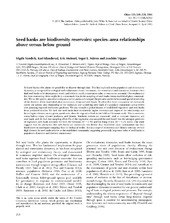| dc.contributor.author | Vandvik, Vigdis | |
| dc.contributor.author | Klanderud, Kari | |
| dc.contributor.author | Meineri, Eric Pierre F | |
| dc.contributor.author | Måren, Inger Elisabeth | |
| dc.contributor.author | Töpper, Joachim Paul | |
| dc.date.accessioned | 2016-04-12T12:38:24Z | |
| dc.date.available | 2016-04-12T12:38:24Z | |
| dc.date.issued | 2015-05-26 | |
| dc.Published | Oikos 2015, 125(2):218-228 | eng |
| dc.identifier.issn | 1600-0706 | en_US |
| dc.identifier.uri | http://hdl.handle.net/1956/11900 | |
| dc.description.abstract | Soil seed banks offer plants the possibility to disperse through time. This has implications for population and community dynamics, as recognised by ecological and evolutionary theory. In contrast, the conservation and restoration literature often find seed banks to be depauperate, weedy and without much conservation value or restoration potential. One explanation for these contrasting views might lie in a systematic bias in the sampling of seed banks versus established plant communities. We use the species–area relationship as a tool to assess and compare the per-area species richness and spatial structuring of the diversity of the established plant community versus soil seed banks. To allow this direct comparison we extensively survey the species–area relationship of the vegetation and underlying seed bank of a grassland community across twelve sites spanning regional bioclimatic gradients. We also compile a global dataset of established vegetation and seed banks from published sources. We find that seed banks have consistently higher intercepts and slopes of the relationship, and hence higher diversity at any given spatial scale, than the vegetation both in the field and literature study. This is consistent across habitat types, climate gradients, and biomes. Similarity indices are commonly used to compare vegetation and seed bank, and we find that sampling effort (% of the vegetation area sampled for seed bank) was the strongest predictor of vegetation–seed bank similarity for both the Sørensen (R2 = 0.70) and the Raup–Crick (R2 = 0.25) index. Our study suggests that the perception that seed banks are intrinsically less diverse than established plant communities has been based more on inadequate sampling than on biological reality. Across a range of ecosystems and climatic settings, we find high diversity in seed banks relative to the established community, suggesting potentially important roles of seed banks in population dynamics and diversity maintenance. | en_US |
| dc.language.iso | eng | eng |
| dc.publisher | Wiley | en_US |
| dc.rights | Attribution CC BY | eng |
| dc.rights.uri | http://creativecommons.org/licenses/by/3.0/ | eng |
| dc.title | Seed banks are biodiversity reservoirs: species–area relationships above versus below ground | en_US |
| dc.type | Peer reviewed | |
| dc.type | Journal article | |
| dc.date.updated | 2016-03-21T09:15:20Z | |
| dc.description.version | publishedVersion | en_US |
| dc.rights.holder | Copyright 2015 the authors | en_US |
| dc.identifier.doi | https://doi.org/10.1111/oik.02022 | |
| dc.identifier.cristin | 1215458 | |
| dc.relation.project | Norges forskningsråd: 184912 | |

